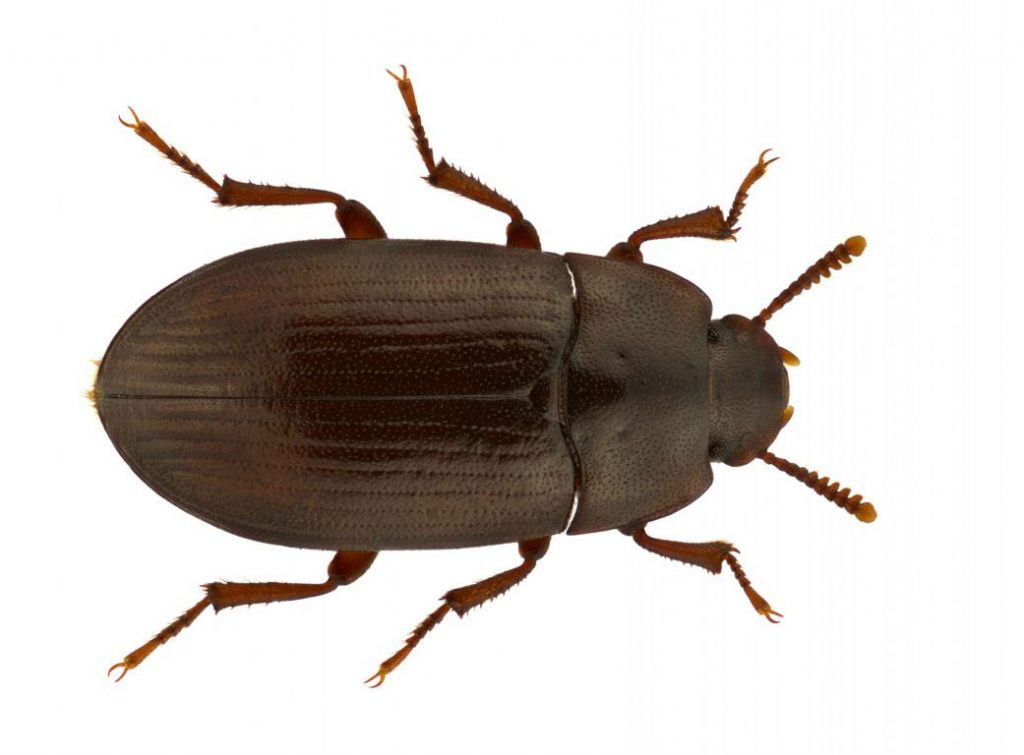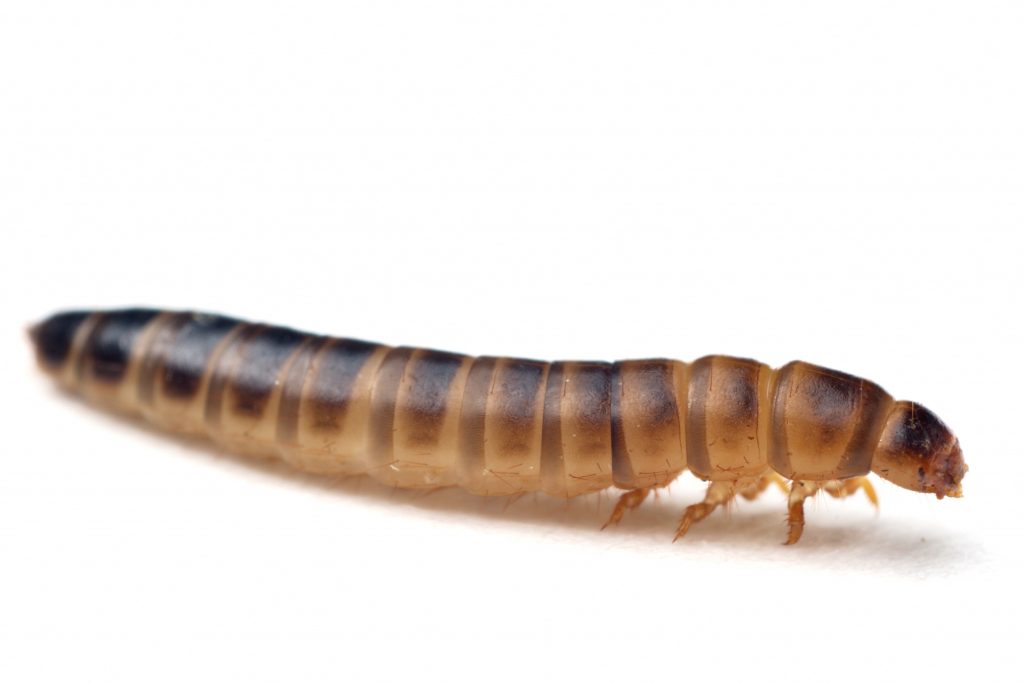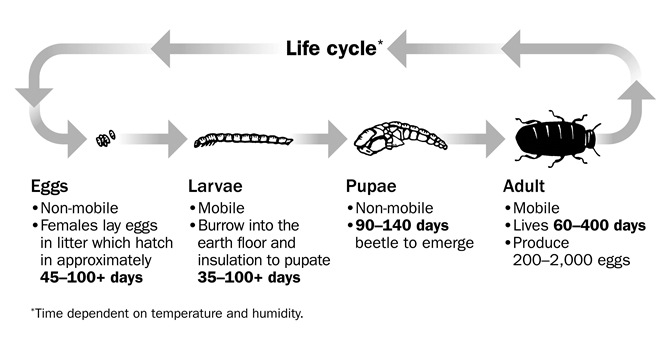
Alphitobius diaperinus © Shutterstock
Another pest we would like to introduce is the litter beetle (Alphitobius diaperinus). For people who do not work on poultry farms, this may sound like a harmless beetle, but it can cause a great deal of damage in said farms and even be harmful to human health.
Benefits and advantages
To begin with, we would like to take a quick detour and look at the exciting benefits of the litter beetle. The larvae of these beetles can be a nutritious snack. Yes, you read that right. The so-called ‘buffalo worms’ have a high protein content and contain essential amino acids, important essential vitamins, and nutrients. That’s why you can already order them from online shops – alive, frozen or freeze-dried.1
Two young German entrepreneurs have also built their company on this nutritious fact, achieving steady growth since 2014. They make burgers based on insects. The only difference is that besides lettuce and sauces, vegetable ingredients and insects are used instead of beef between the buns.2
Raising these beetle larvae is also much easier and much more environmentally friendly and gentler on resources than raising cattle for “normal” meat production.
But these beetle larvae are also a good and vital food source for other insects and reptiles.3
Dangers and economic damage
Litter beetle larvae can cause structural damage to insulation in poultry houses when they seek a place to burrow to pupate, reducing insulation by up to 30%, which in turn increases energy costs.

Alphitobius diaperinus larva © Shutterstock
Unfortunately, they can also transmit over 60 different diseases. Whether larvae or adult beetles, the pathogens are in their intestine and on their body, making transmission easy. These beetles often infect young chicks with salmonella, which can be easily transmitted to the other animals. Birds can be infected with salmonella from consuming just a single bug. And this can have dire economic consequences.
Humans are also at risk and can develop allergies if exposed to high numbers of these beetles for too long. Workers in infested poultry houses are a good example. Neighbours of infested areas need also be careful, as the beetles are nocturnal and attracted to light and warmth and can quickly migrate to/into neighbouring (residential) areas.4
Characteristics and properties
Appearance:
Alphitobius diaperinus are dark brown to black shiny and grow to 5 to 6 mm in size. The larvae are elongated, yellow and grow up to 15 mm in size.
Habitat/occurrence:
The litter beetle often makes its home in bakeries or poultry farms, as it particularly likes warmth and high humidity. Insulating materials and floor coverings provide good environments for breeding, and the larvae often eat insulating and packaging materials. The main food of the adult beetle is grain, preferably mouldy or rotten.
Life cycle:
The Alphitobius diaperinus female lays 14 to 20 eggs one day after mating using a laying tube at hidden food sources. These are about 1.5 mm in size, elliptical in shape, slightly dented at the sides and sticky. Depending on the temperature, preferably warm, the larvae hatch after about 5 days and start feeding immediately. The larvae pass through several stages and moult a total of seven times before they pupate. Under optimal conditions (32°C), the development to an adult beetle takes only 34 to 53 days. At temperatures below 10°C the beetle cannot develop.5 In her lifetime, the female can lay an average of 200 to 400 eggs, but they have also been known to lay up to 2000 eggs.6 An adult litter beetle can live up to 12 months.7

Life Cycle of Alphitobius diaperinus8
Jesmond products and efficacy + application/dilution
Although these beetles reproduction takes longer compared to other pests, an initially unnoticed infestation can become very persistent. This is because, especially in poultry farming, Alphitobius diaperinus can appear in masses creating an extremely uncomfortable environment. As soon as an infestation is discovered, it is of course best to immediately take proactive measures.
Detection of infestations at an early stage is possible with the use of traps. Tube traps are often used in poultry farms for monitoring. These tubes are made of PVC, about 10 to 15 cm long, filled with corrugated cardboard and provide shelter for the beetles.
In addition, it also makes sense to check the litter for adult or immature beetles and to check the insulation of the house for damage.7
To control an acute infestation and also as prevention, we recommend our product BOMBEX® Farumy. It has a high performance thanks to the patented microencapsulation technology. BOMBEX® Farumy has an immediate and long-lasting effect. Despite its more ecological water-based formulation, the tailored release of the active ingredients from the microscopic membrane capsules enables 12 weeks of protection. In addition, it is convenient to use, does not irritate the skin or respiratory tract, and has no unpleasant odour.
In case of severe infestation, 50-100 ml of BOMBEX® Farumy can be diluted with 5 L of water. With this rate all infested areas can be treated, with special attention to doors, windows and ventilation openings, crevices and places where the beetles or eggs and larvae hide.
BOMBEX® Farumy can also be used for space treatment/fogging. Here, 75 ml is diluted in water to treat 500 m³.
When using BOMBEX® Farumy the following points should be observed:
- Follow the instructions on the label for the correct dilution.
- Shake well before opening container.
- Ensure that the container and sprayer have been cleaned properly.
- Properly mix and stir the spray solution.
- Shake backpack sprayer while walking and use reservoir agitations if available.
- Use up all the material on the same day. The diluted mixture should not be stored.
- Ensure a medium to coarse spray with enough pressure to penetrate cracks and crevices.
- Wet the surfaces well until the point of runoff (50 mL/m²).
- Dilute Bombex®-product in water. Do not add other products or additives (whether spraying or fogging).
- Consider the principles of IPM (Integrated Pest Management).
- If the treatment is carried out after limewashing (or disinfection), the surfaces must be dry before treatment with Bombex® to ensure the best effectiveness.
Successful test implementation with BOMBEX® Farumy
Our product BOMBEX® Farumy has been successfully used in poultry farms all over Europe. One of Jesmond’s partners, recently monitored the use of the product in a commercial poultry farm. The total house area was 4,200 m2, with a total of 70,000 chickens.
To determine the Alphitobius diaperinus population, tube traps were placed at regular intervals in the houses. More than 18,000 adult litter beetles, over 3,000 larvae and a few pupated larvae were counted (in only 10 traps).
An innovative protocol was developed for the treatment with BOMBEX® Farumy to maximise the benefits of the product.
One week after application, no living adult beetles were found. At the end of the population cycle in the chicken farm, the efficacy was still 99% on adult beetles and 66% on larvae. Due to the long-lasting efficacy, beetle reproduction was prevented, which ultimately reduced the number of larvae even further.
For detailed information on BOMBEX® Farumy and treatment protocol, please contact the Jesmond team. Depending on the country, Jesmond also offers alternative products suitable for use in poultry production.
And finally. Whilst the litter beetle larvae taste great when properly prepared and are a good vegetarian alternative, in the poultry environment, the beetles are considerably less enjoyable. Even though they are a fascinating insect in some areas, in the poultry environment they certainly need to be controlled and, if necessary, removed all together to avoid worsening damage.
Click here to see: WORLD OF LITTER BEETLES – REFERENCES